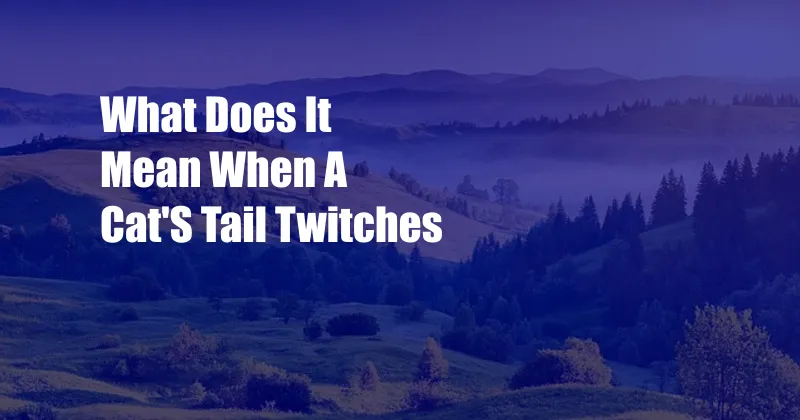
The Enigma of Cats’ Twitching Tails: Unveiling the Feline Code
As a fervent cat enthusiast, I have always been utterly enthralled by the enigmatic nature of our feline companions. Their sleek bodies, piercing eyes, and graceful movements have captivated my imagination since childhood. Among the many feline behaviors that have piqued my curiosity, one particular gesture stands out: the twitching of their tails. This seemingly innocuous action has turned out to be a rich tapestry of communication, revealing a complex world of emotions, intentions, and even health conditions.
The enigmatic language of cats’ tails has inspired countless hours of observation and study, resulting in a vast body of knowledge that helps us better understand and connect with our beloved furry friends. By delving into the subtle nuances of tail movements, we can gain a deeper insight into their inner thoughts and well-being.
Deciphering the Feline Tail Telegraph
Just as humans communicate with words and gestures, cats rely on their tails as a primary means of expressing themselves. The position, movement, and even thickness of their tails can convey a wide range of emotions, from contentment to aggression. Understanding these tail signals is crucial for fostering a harmonious and fulfilling relationship with our feline companions.
When a cat’s tail is held high and straight up, it typically signifies confidence and contentment. This posture is often accompanied by a slight curl at the tip, expressing a playful or affectionate mood. Conversely, a tail held low and close to the body can indicate fear, submission, or even aggression. The thickness of the tail can also provide clues about the cat’s emotional state; a puffed-up tail often signifies agitation or anger.
Unraveling the Tail’s Movements
The dynamic movements of a cat’s tail are just as expressive as its position. A gentle side-to-side swish can indicate curiosity or interest, while a rapid twitching motion can signal irritation or annoyance. A sudden flick of the tail can be a warning sign, indicating that the cat is feeling threatened or defensive.
Perhaps the most intriguing tail movement is the twitching of the tail tip. This subtle gesture can convey a variety of emotions, depending on the context. A slight twitch can indicate excitement or anticipation, while a more pronounced twitch can express frustration or even pain. By carefully observing the tail’s movements, we can better understand our cat’s mood and respond appropriately.
Tail Health and Medical Implications
In addition to its communicative role, a cat’s tail can also provide clues about their health. A limp or drooping tail can be a sign of pain or injury, while a constantly twitching tail can indicate neurological issues. If you notice any unusual changes in your cat’s tail, it is always advisable to consult with a veterinarian to rule out any underlying medical conditions.
Maintaining a healthy tail is essential for a cat’s well-being. Regular brushing and grooming can help prevent mats and tangles, while providing an opportunity to inspect the tail for any signs of injury or irritation. Additionally, ensuring that your cat has a balanced diet and plenty of exercise can contribute to overall tail health.
Tips for Interpreting Tail Language
Becoming proficient in interpreting cat tail language takes time and practice. Here are a few tips to help you get started:
- Observe your cat in different situations. Pay attention to their tail movements and try to identify the emotions or intentions they are expressing.
- Consider the context. The environment and other feline behaviors can provide valuable clues about the meaning of tail movements.
- Don’t rely solely on tail language. Combine tail observations with other body language cues, such as ear position and vocalizations, for a more comprehensive understanding.
By following these tips, you can gradually develop a deeper understanding of your cat’s unique tail language, fostering a stronger and more rewarding bond.
Frequently Asked Questions on Cat Tail Twitching
Q: Why does my cat’s tail twitch when I pet it?
A: Gentle twitching of the tail tip during petting is often a sign of pleasure and contentment.
Q: What does it mean when my cat’s tail is twitching and puffed up?
A: This combination can indicate fear, aggression, or agitation. It is important to give your cat space and avoid approaching them.
Q: My cat’s tail is twitching constantly, even when they seem calm. Is this a sign of a problem?
A: Constant tail twitching can be a symptom of neurological issues or underlying medical conditions. It is recommended to consult with a veterinarian for evaluation.
Q: How can I help keep my cat’s tail healthy?
A: Regular brushing and grooming, a balanced diet, and adequate exercise can all contribute to a healthy feline tail.
Q: Is understanding tail language the key to a harmonious relationship with my cat?
A: While tail language is a valuable tool for communication, it is just one aspect of understanding your cat’s needs and behaviors. A holistic approach that considers all aspects of feline well-being is essential for building a strong and affectionate bond.
Conclusion
Embarking on a journey to decipher the enigma of cats’ twitching tails is like stepping into a secret world, where communication takes on an entirely new dimension. By carefully observing and interpreting tail movements, we can unlock a deeper understanding of our feline companions, strengthening our bond and enhancing their well-being.
Are you curious to explore more about the fascinating world of cat behavior? Share your thoughts and questions in the comments section below. Together, let us continue to unravel the mysteries that surround these extraordinary creatures we call cats.